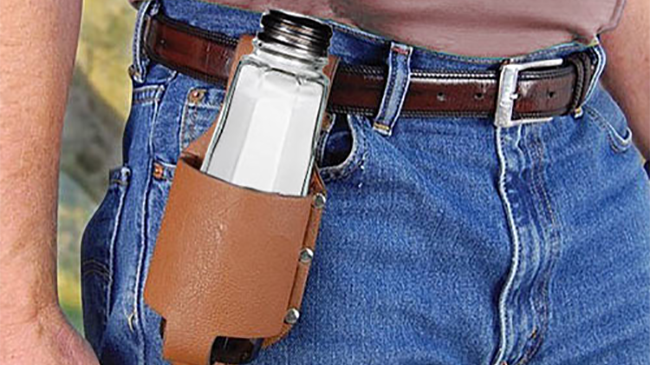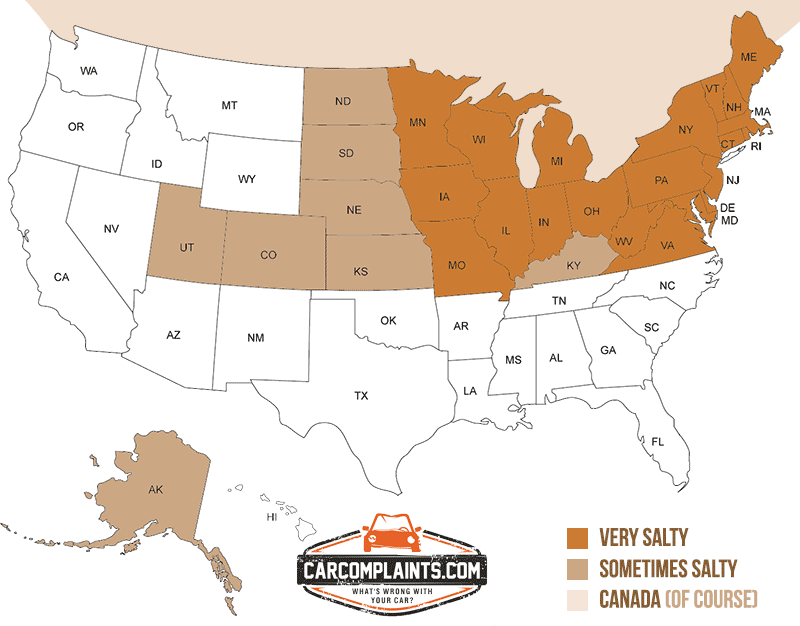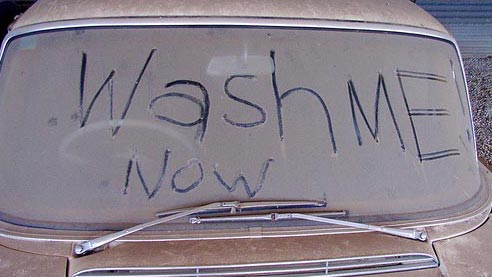The Salt Belt States
Road salt. It's great for melting ice, and awful for just about everything else.

Cold-weather states that have to use a heavy dose of salt in the winter are sometimes referred to as the “salt belt.” Every now and again you’ll see a recall or investigation that is limited to this this specific region.
Understandably, the “salt belt” is also known as the “rust belt.”
“The biggest threat salt poses to a vehicle is rust, which is accelerated by repeated exposure to salt. Rust on certain parts of a car can create a slew of problems ranging from hydraulic brake system leaks to subframe damage.” — Accuweather.com
The states in this belt are, as you’d expect, found in New England, the Mid-Atlantic and the upper Midwest. The belt, however, sometimes grows or shrinks depending on the recall.
The “Salt Belt” 21
Here are the 21 states (plus one district) that you’ll almost always see listed as part of the “salt belt”:
Connecticut, Delaware, Illinois, Indiana, Iowa, Maine, Maryland, Massachusetts, Michigan, Minnesota, Missouri, New Hampshire, New Jersey, New York, Ohio, Pennsylvania, Rhode Island, Vermont, Virginia, West Virginia, Wisconsin and Washington D.C.

Depending on what models are being recalled, Canada can be included too because, well … it’s Canada and it snows a lot there.
“Why isn’t Alaska on the primary [salt belt] list? Maybe Alaskans don’t like road salt. Maybe they just ride around on polar bears all winter. I’ve never been, so I can’t say for sure.”
Other states such as Alaska, Colorado, Kansas, Kentucky, Nebraska, North Dakota, South Dakota, Utah are also sometimes considered part of the “salt belt.”
Why isn’t Alaska, our northernmost and one of the snowiest states, on the primary list? I’m not really sure. Maybe Alaskans don’t like road salt. Maybe they just ride around on polar bears all winter. I’ve never been, so I can’t say for sure.
The Reason For All This Salt
Salt is used on roads because it helps lower the melting point of ice, to a point. A 10% salt solution will lower water’s freezing point from 32 F (0 C) to 20 F (–6 C). But once it starts to get colder things get a little science-y and salt’s effectiveness starts to fade.
How Salt Affects Your Car
Salt has a nasty habit of finding places where it can do the most damage. Take that small nick in the paint of your car that came courtesy of a rogue shopping cart. Salt will nestle in past the paint, attach itself top your car’s exposed metal frame and eat that sucker dry. Salt will also eat through:
- Your paint, if you haven’t properly waxed
- Your struts and shocks
- Fuel tanks and other components if there are bad welds
- Brake lines and other good times
To combat salt corrosive awfulness, manufacturers will sometimes treat your car with anti-rust sprays, zinc-rich galvanizing compounds and rubberized underbody coatings that work … for a while. Sometimes you’ll even receive an anti-corrosion warranty with a new car that lasts a couple years.
Preventing Rust and Corrosion on Your Car
Your best bet is to wax your car before winter and then regularly wash it, when you can, throughout the cold months.

Some say that salt’s corrosive properties slow down once the salt dries into a crusty white dust all over your car. Those people are very wrong and you should never take advice from them again.
“Go through a car wash that has an under-spray,” says Manager of Vehicle Services at Firestone Complete AutoCare, Joe Roger “That will try to reduce the chances that all that salt and salt water will get on the vehicle and start to corrode.”